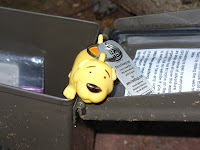So recently the term geocaching has been flying forth from my mouth with increasing frequency. I had been introduced to the idea many years ago, but since I was a poor college student with no money to spend on a handheld GPS unit- I never gave it a go. Fast forward to a month or two ago, when one of my coworkers (Michelle) was surprised to find out I knew what this whole geocaching thing was all about. She took me out for my first time a little while back and I was hooked- hence the increase of the term in my vocabulary. All that being said- I still haven't said a word about what it is. Well- to sum it up very nicely... here's a t-shirt that I find amusing
Hehe... ok, now to expand on that a bit. From geocaching.com- "Geocaching (pronounced geo-cashing) is a worldwide game of hiding and seeking treasure. A geocacher can place a geocache in the world, pinpoint its location using GPS technology and then share the geocache's existence and location online. Anyone with a GPS device can then try to locate the geocache"
So it's all pretty simple. Get your hands on a GPS unit, hit up the aforementioned website to find some caches near you, plug the coordinates of said caches into said GPS, and off you go. Caches range in size from micro (film canisters, hide-a-key magnets, M&M minis containters, etc) to large (ammo boxes, tupperware containers). Generally the micro caches are hidden in more populated areas, while you'll probably have to hit your local woods to find the larger caches. At the very minimum- all a cache needs to contain is a log for those who find it to sign, but the larger ones will also contain various little treasures ("swag" in caching terms). It's a good idea to bring some swag of your own along with you, because caching etiquette says that if you take something from the cache, you leave something of equal value behind. Some caches also contain "trackables", which are coins or items with a Travel Bug dogtag attached to them. The coin or dogtag will contain a unique ID that you can lookup online to find out the original location of that item and it's path to you. Some items even have a destination they are trying to reach, or even a mission to complete.
(This is T-Bone. He's from Virgina and has traveled south to the Carolinas before a long trip up north to the northwestern part of Pennsylvania, and then eventually making his way to a cache near the Middle Creek Reservoir where I found him.)
Caches are also rated on a 5-star scale on both difficulty to find as well as the terrain to get to the cache. This information really comes in handy on the woodsy caches so you have an idea what kind of hike you have in front of you. From what I understand- a full 5 star difficulty will require special equipment to find the cache (scuba or rock climbing equipment for example).
So yea- that's a pretty good introduction to geocaching I think. For more info- hit up geocaching.com or contact me... I'm pretty new to it as well, but I'm always happy to talk about it! Hehe. And if you wanna try it sometime, let me know! I'm waiting for payment to clear on a newer GPS I bought on ebay, so I should have that within a week and I'll be looking to try it out. The first one I bought was an older model that didn't have the newer high sensitivity GPS chips in them, so it's accuracy under tree cover was pretty crappy. I'll end this post with a couple pics from my geocaching adventures thus far...



This is my first piece of swag! I name him C.C. (short for Cache Cow)

Ordinary looking stump? Nope!!


No comments:
Post a Comment